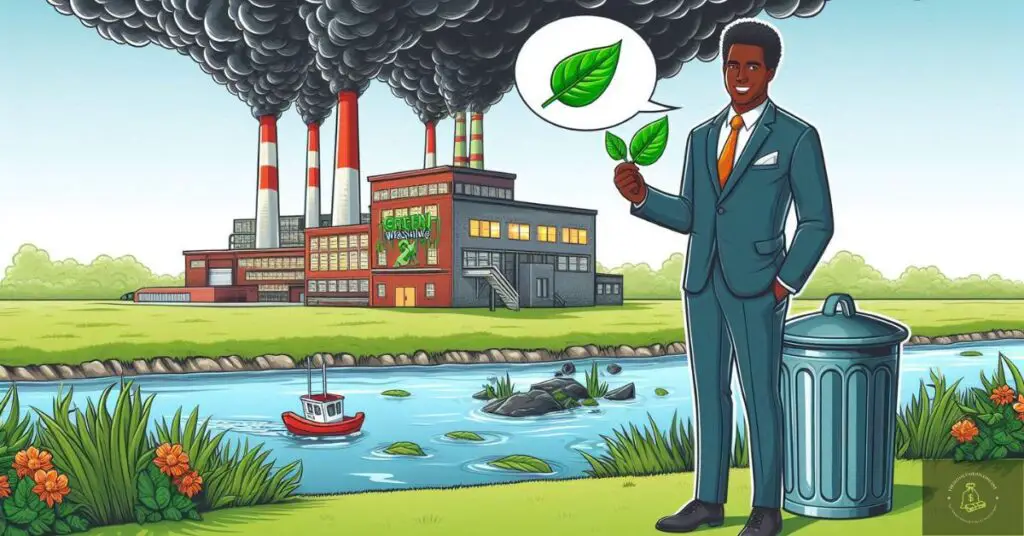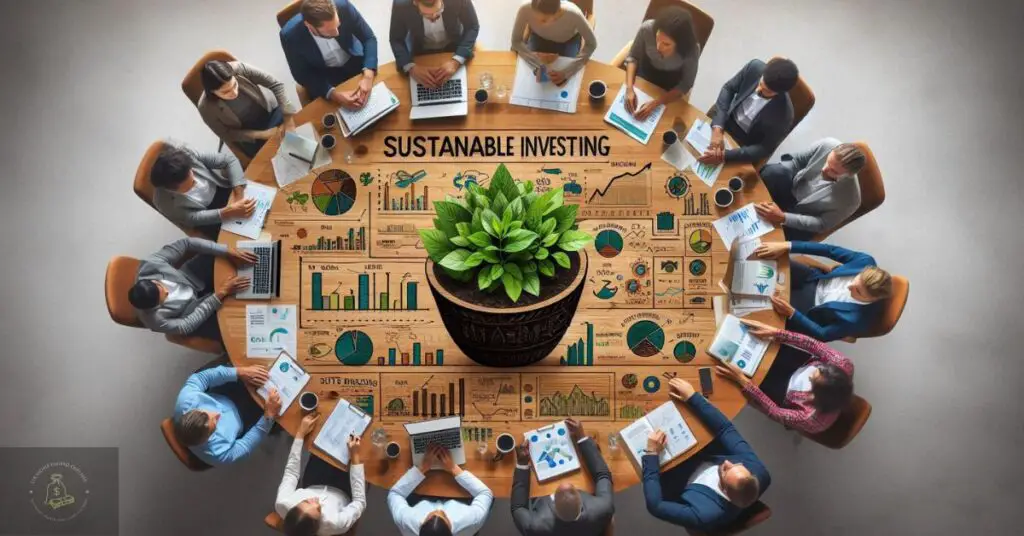What Does Greenwashing Mean in Sustainable Investing? Sustainable investing has gained significant traction over the years, attracting investors who want to align their financial goals with their values. The idea is simple: put your money into companies and funds that are committed to environmental sustainability, social responsibility, and good governance.
But here’s the catch—sometimes what appears to be a sustainable investment is actually far from it. This deceptive practice is known as greenwashing, where companies or funds exaggerate or fabricate their environmental credentials to attract eco-conscious investors. So, what does greenwashing really mean in the context of sustainable investing? Let’s explore.
What Does Greenwashing Mean in Sustainable Investing?
Introduction
At first glance, greenwashing might seem like just another buzzword, but it’s a critical issue that can mislead investors and undermine the integrity of sustainable investing.
Essentially, greenwashing occurs when companies or investment funds present themselves as more environmentally friendly or socially responsible than they truly are.
This can happen through misleading marketing, selective disclosure of information, or outright false claims. As a result, investors might end up supporting companies that are not genuinely committed to sustainability, thereby inadvertently contributing to the very issues they wish to avoid.
What is Greenwashing?

Definition of Greenwashing
Greenwashing is the act of making false or misleading claims about the environmental benefits of a product, service, or company practice. It involves exaggerating the positive environmental impact or downplaying the negative aspects.
In other words, it’s a form of marketing spin designed to make a company appear more sustainable than it actually is. The term “greenwashing” combines “green,” referring to environmentalism, with “whitewashing,” which means covering up or glossing over the truth.
History of Greenwashing
The concept of greenwashing dates back to the 1980s, although the practice itself has been around for much longer. As environmental awareness grew, so did the number of companies wanting to capitalize on the trend.
However, not all companies were sincere in their efforts to go green. Some began making exaggerated or false claims about their sustainability practices to attract eco-conscious consumers and investors.
Over time, the term “greenwashing” was coined to describe this deceptive practice, and it has since become a significant concern in the world of sustainable investing.
Understanding Sustainable Investing

Definition of Sustainable Investing
Sustainable investing, also known as socially responsible investing (SRI) or environmental, social, and governance (ESG) investing, involves choosing investments that align with one’s ethical values.
It’s about selecting companies and funds that not only offer financial returns but also contribute positively to society and the environment.
For example, a sustainable investor might choose to invest in renewable energy companies or businesses with strong labor practices. The goal is to generate long-term financial returns while also making a positive impact on the world.
The Growth of Sustainable Investing
In recent years, sustainable investing has moved from the fringes to the mainstream. More and more investors are seeking to align their portfolios with their personal values, and the market has responded accordingly.
Today, trillions of dollars are managed in funds that claim to prioritize environmental, social, and governance factors. This rapid growth has been driven by increased awareness of issues like climate change, social inequality, and corporate governance.
However, with this growth comes the risk of greenwashing, as companies and funds may be tempted to overstate their sustainability credentials to attract investors.
How Greenwashing Manifests in Investing
Misleading Claims
One of the most common forms of greenwashing in investing is the use of misleading claims. Companies may make broad, vague statements about their environmental or social initiatives without providing concrete evidence to back them up.
For instance, a company might claim to be “committed to sustainability” without specifying how it measures or achieves this commitment. Similarly, an investment fund might advertise itself as “green” or “socially responsible” without providing details on its selection criteria or the actual impact of its investments.
Overstating Environmental Benefits
Another tactic used in greenwashing is overstating the environmental benefits of a product, service, or investment. For example, a company might highlight a single environmentally friendly initiative while ignoring or downplaying its broader environmental impact.
This can create a skewed perception, leading investors to believe that the company is more sustainable than it actually is. In the context of investing, a fund might claim to be 100% sustainable but still include companies with poor environmental practices in its portfolio.
The Role of Marketing in Greenwashing
Marketing plays a significant role in greenwashing. Companies know that “green” sells, and they use this to their advantage by creating marketing campaigns that emphasize their sustainability efforts, even if those efforts are minimal or insincere.
Buzzwords like “eco-friendly,” “sustainable,” and “green” are often used to appeal to consumers’ and investors’ consciences. However, without transparency and accountability, these words can be meaningless.
In the worst cases, marketing becomes a tool for deception, creating a false image of sustainability that doesn’t reflect the company’s actual practices.
Identifying Greenwashing in Investments
Red Flags to Watch Out For
Identifying greenwashing can be challenging, especially when companies go to great lengths to appear sustainable. However, there are red flags that investors can look out for.
One of the most significant is the use of vague or ambiguous language, such as terms like “eco-friendly” or “natural” that are not clearly defined or substantiated.
Another red flag is the lack of third-party certifications or independent verification of a company’s sustainability claims.
If a company is genuinely committed to sustainability, it should have no problem providing evidence to support its claims.
Also Read – Can You Consolidate Car Loans and Credit Cards?
How to Spot Genuine Sustainable Investments
So, how can investors distinguish between genuine sustainable investments and those that are merely greenwashed? The key is to dig deeper and conduct thorough research.
Look for companies and funds that are transparent about their sustainability practices, with clear, measurable goals and third-party certifications.
Pay attention to the details and be skeptical of claims that seem too good to be true. Remember, a genuinely sustainable investment will stand up to scrutiny and provide detailed information about its environmental and social impact.
The Impact of Greenwashing on Investors
Financial Risks
Greenwashing poses significant financial risks to investors. When you invest in a company that is greenwashing, you may be putting your money at risk. If the truth about the company’s sustainability practices comes to light, its stock could plummet, leading to substantial losses.
Additionally, greenwashing can distort the market by making it difficult to differentiate between genuinely sustainable companies and those that are merely pretending to be.
This can result in misallocation of capital and undermine the integrity of the sustainable investing market.
Ethical Concerns
Beyond the financial risks, greenwashing raises serious ethical concerns. As an investor, you want to know that your money is being used to support companies that are making a positive impact on the world.
Greenwashing undermines this goal by making it harder to identify which companies are truly committed to sustainability.
It can lead to a sense of betrayal and disillusionment when you discover that the companies you thought were doing good are actually engaging in deceptive practices.
Why Companies Engage in Greenwashing
Pressure to Appear Sustainable
In today’s business environment, sustainability is no longer just a nice-to-have—it’s a must-have. Consumers and investors alike are demanding more from the companies they support, and this pressure has led some businesses to engage in greenwashing.
Rather than doing the hard work of becoming genuinely sustainable, some companies take shortcuts, using greenwashing as a way to appear environmentally friendly without making meaningful changes.
This allows them to capitalize on the growing demand for sustainable products and investments without actually committing to sustainability.
Lack of Regulations
Another reason greenwashing is so prevalent is the lack of strict regulations. While there are some guidelines in place, they are often not sufficient to prevent companies from making misleading claims.
The rules around what can be labeled as “green” or “sustainable” are still relatively loose, leaving plenty of room for companies to bend the truth.
Without stronger regulations and enforcement, greenwashing will continue to be a problem in the sustainable investing space.
The Role of Regulatory Bodies

Current Regulations on Greenwashing
Currently, regulations around greenwashing vary widely by country and industry. In some regions, regulatory bodies have taken steps to crack down on false sustainability claims, but enforcement can be inconsistent.
For example, the European Union has implemented stricter guidelines for ESG disclosures, requiring companies to provide more detailed and transparent information about their sustainability practices.
However, in many other places, the rules are still catching up, and companies can often get away with greenwashing without facing significant consequences.
Future of Regulations in Sustainable Investing
The good news is that awareness of greenwashing is growing, and there is increasing pressure on regulatory bodies to take action.
In the future, we can expect to see more stringent regulations and better enforcement of existing rules. This will make it harder for companies to engage in greenwashing and easier for investors to identify genuinely sustainable investments.
As the regulatory landscape evolves, companies will need to be more transparent and accountable in their sustainability practices, leading to a more authentic and trustworthy market for sustainable investing.
How to Avoid Greenwashed Investments
Conducting Due Diligence
The first step in avoiding greenwashed investments is to conduct thorough due diligence. This means going beyond the marketing materials and digging into the details of a company’s sustainability practices.
Review their sustainability reports, check for third-party audits, and investigate their supply chains. While this might sound like a lot of work, it’s essential to ensure that your investments align with your values.
By doing your homework, you can avoid falling for greenwashing and instead support companies that are genuinely committed to sustainability.
How to Avoid Greenwashed Investments
Conducting Due Diligence
The first step in avoiding greenwashed investments is to conduct thorough due diligence. This means going beyond the marketing materials and digging into the details of a company’s sustainability practices.
Review their sustainability reports, check for third-party audits, and investigate their supply chains. While this might sound like a lot of work, it’s essential to ensure that your investments align with your values.
By doing your homework, you can avoid falling for greenwashing and instead support companies that are genuinely committed to sustainability.
Relying on Third-Party Verification
Another effective way to avoid greenwashing is to rely on third-party verification. Certifications from reputable organizations like the Global Reporting Initiative (GRI), the Sustainability Accounting Standards Board (SASB), or the Carbon Trust can provide assurance that a company’s sustainability claims are legitimate.
These organizations have strict standards and conduct thorough assessments, so if a company has their seal of approval, you can be more confident in its sustainability efforts.
Understanding the Criteria Behind Labels
Not all sustainability labels and certifications are created equal. Some labels may have rigorous standards, while others may have looser criteria that allow companies to make vague or unverified claims.
To avoid greenwashing, it’s important to understand the criteria behind the labels. Look for certifications that require third-party audits and clear, measurable standards.
For instance, the B Corporation certification requires companies to meet high standards of social and environmental performance, transparency, and accountability. By focusing on labels with strict criteria, you can make more informed investment decisions.
Diversifying Your Portfolio
Diversification is another key strategy for avoiding greenwashing. By spreading your investments across different sectors, industries, and regions, you can reduce your exposure to any single company or fund that may be engaging in greenwashing.
This not only helps protect your portfolio from potential risks but also ensures that your investments are supporting a broader range of genuinely sustainable companies. Additionally, diversification can help you take advantage of emerging opportunities in the sustainable investing space, such as new technologies or innovative business models.
Staying Informed and Updated
The landscape of sustainable investing is constantly evolving, with new regulations, standards, and best practices emerging all the time.
To avoid greenwashing, it’s important to stay informed and updated on the latest developments in the field. Follow industry news, attend webinars or conferences, and engage with experts and thought leaders in the space.
By keeping your knowledge current, you can better navigate the complexities of sustainable investing and avoid falling for greenwashing tactics.
Also Read – Student Loans and Credit Cards are two kinds of Loans that most often have
The Future of Sustainable Investing
Moving Towards Genuine Sustainability
The future of sustainable investing is bright, but it hinges on one key factor: authenticity. Investors are becoming savvier, and they’re demanding more transparency and accountability from the companies and funds they invest in.
This shift towards genuine sustainability is encouraging, as it means that greenwashing will become less effective over time.
As more companies realize that they can’t just talk the talk—they need to walk the walk—sustainable investing will continue to grow and evolve, benefiting both the planet and your portfolio.
The Role of Technology in Transparency
Technology is playing an increasingly important role in enhancing transparency in sustainable investing. Blockchain, for example, can be used to create immutable records of a company’s sustainability practices, making it harder for them to make false claims.
Similarly, AI and big data can help investors analyze vast amounts of information to identify patterns of greenwashing.
As these technologies become more widespread, they’ll make it easier for investors to distinguish between truly sustainable companies and those that are just putting on a green façade.
The Evolution of Investor Expectations
Investor expectations are evolving, and this is driving change in the sustainable investing landscape. Today’s investors are not just looking for financial returns; they also want to know that their money is making a positive impact on the world.
This has led to a greater emphasis on transparency, accountability, and measurable outcomes. As investors continue to raise the bar, companies will need to step up their sustainability efforts to meet these expectations.
This shift is likely to result in a more rigorous and authentic approach to sustainable investing, where greenwashing is less tolerated and more easily exposed.
The Impact of Regulatory Changes
Regulatory changes are also expected to play a significant role in shaping the future of sustainable investing. As governments and regulatory bodies around the world become more aware of the risks of greenwashing, we can expect to see stricter regulations and more robust enforcement.
This could include mandatory sustainability disclosures, standardized reporting frameworks, and penalties for misleading claims.
These changes will help create a more level playing field, where companies that are genuinely committed to sustainability are rewarded, and those that engage in greenwashing are held accountable.
Conclusion
Greenwashing is a serious issue in the world of sustainable investing, but it’s not insurmountable. By staying informed, conducting thorough research, and relying on third-party verification, you can protect yourself from falling for greenwashed investments.
As regulations tighten and technology advances, the future of sustainable investing looks promising. It’s a journey towards a more ethical, transparent, and genuinely green market.
So, the next time you’re considering a sustainable investment, remember to look beyond the surface and ensure that your money is truly supporting the causes you care about.
FAQs
1. What are the most common greenwashing tactics?
Common greenwashing tactics include vague or misleading language, such as labeling products as “eco-friendly” without providing specifics. Other tactics involve overstating environmental benefits, using irrelevant green labels, or promoting minor environmental initiatives while ignoring broader unsustainable practices.
2. How can investors protect themselves from greenwashing?
Investors can protect themselves by conducting thorough due diligence, seeking out third-party certifications, and researching the companies or funds they’re considering. It’s important to look for transparency in sustainability reports and verify the claims made by companies.
3. Is greenwashing illegal?
While greenwashing can be misleading and unethical, it’s not always illegal. However, in some cases, it can violate advertising standards or consumer protection laws, leading to fines or legal action. The legality of greenwashing depends on the specific claims made and the regulations in the jurisdiction where the company operates.
4. What are some examples of greenwashed investments?
Examples of greenwashed investments include funds that claim to be “100% sustainable” but include companies with poor environmental practices or businesses that market themselves as eco-friendly while contributing to significant pollution or deforestation. These investments often focus on marketing rather than actual impact.


1 thought on “What Does Greenwashing Mean in Sustainable Investing?”